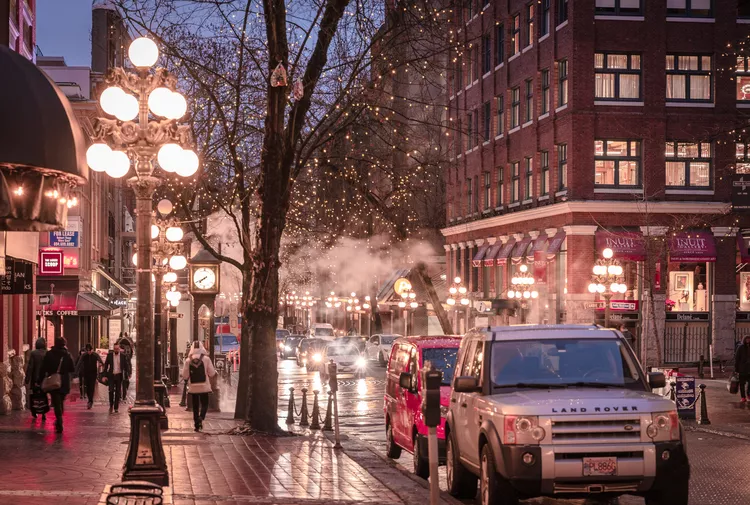Summary
Shopping, Dining, Nightlife & History

Designated as a national historic site, Gastown in Vancouver, BC, serves as a vibrant urban destination characterized by charm, nightlife, exceptional shopping, and a multitude of the city’s highly regarded restaurants.
As the oldest district in Downtown Vancouver (and still considered part of “Downtown” as defined by the City of Vancouver’s official neighborhood boundaries), Gastown is named after “Gassy” Jack Deighton, a steamboat captain who established the first saloon there in 1867. Furthermore, Gastown was also the site of the Hastings Mill sawmill and seaport, as well as the endpoint for the Canadian Pacific Railway. These factors contributed to Gastown becoming an industrial center and a lively area known for its bars, nightlife, and brothels. (Currently, The Diamond cocktail bar occupies a building that once housed one of these notorious establishments.)
Following the Great Depression, Gastown experienced significant decline and reached its lowest point in the 1960s, becoming known as Vancouver’s “skid row.” After undergoing “rehabilitation” in the 1970s, it remained a lower-income region well into the late 1990s and early 2000s. Although it initially attracted some tourists drawn to its historic architecture, cobblestone streets, and landmarks, it was not until the early 2000s that the area began a process of gentrification. Today, Gastown exemplifies urban revitalization and is one of the most coveted locales for young urban professionals, hosting many of the city’s finest restaurants, bars, and retail establishments.

Boundaries of Gastown
Located in the northeast section of Downtown Vancouver, Gastown shares borders with the Downtown Eastside and Chinatown/Strathcona to its east. Officially, Gastown’s boundaries extend from Water Street in the north, Richards Street to the west, Main Street in the east, and Cordova Street to the south.
During the past decade, Gastown has experienced rapid gentrification, leading to an influx of young professionals (ages 20 to 40) acquiring high-end housing options. Residents in Gastown typically maintain smaller households compared to the Vancouver average, likely due to their relative youth, and many being singles or childless couples.
While the area is not as ethnically diverse as its neighbor, Strathcona (home to the historic Chinatown), it does attract a significant number of international immigrants.

Restaurants & Nightlife in Gastown
Gastown ranks among the busiest and most popular Vancouver Nightlife Districts, featuring an array of bars, pubs, and some of Vancouver’s Top Cocktail Bars (including The Diamond and L’Abattoir).
Gastown’s dining scene showcases several unique establishments from distinguished restaurateur Sean Heather, such as The Irish Heather (notable for its famous Long Table Series) and Judas Goat. Other popular venues include Pourhouse and Chill Winston (which boasts one of the premier patios in Vancouver).
The dining establishments of Gastown have gained international recognition due to Mark Brand’s (another leading restaurateur in Gastown) reality show Gastown Gamble, aired between 2011 and 2012, which highlighted Brand’s management of the iconic Save-on-Meats.

Shopping in Gastown
When it comes to shopping in Vancouver for interior design, furniture, and men’s fashion, Gastown stands out as a premier destination, housing numerous independent boutiques and local designers. It is also home to the flagship Fleuvog store; John Fleuvog established his internationally recognized brand in Gastown during the 1970s counterculture movement.

Gastown Landmarks
In addition to its picturesque cobblestone streets and historic structures, Gastown boasts several notable landmarks. Among these is Maple Tree Square, which features a statue of “Gassy” Jack Deighton at its center, and the iconic steam-powered clock located at the intersection of Cambie and Water Street, commonly depicted in postcards from the area. The Gastown Steam Clock is also featured on the cover of Nickelback’s 2011 album Here and Now.





